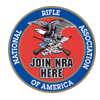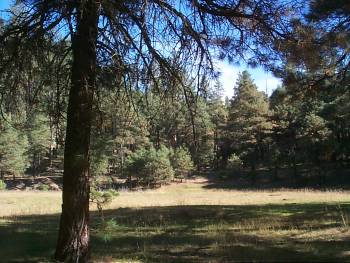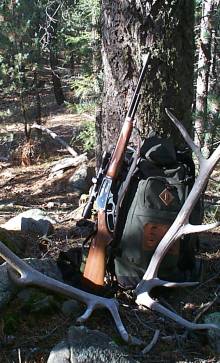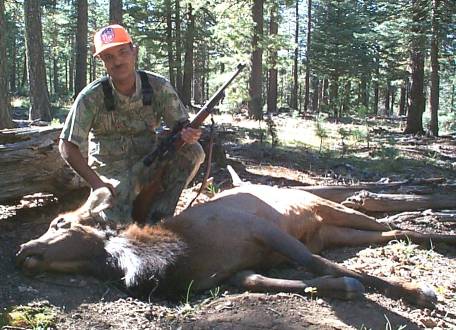
| Articles | Documents | Equipment | Events | Links | Membership | Miscellaneous | Scrapbook | Targets | What's New |
| Another First Elk | December 2003 | ||||||
| Dan Martinez
| |||||||
|
My first was a four-day hunt in the second week of December in Unit 1. Yes, there was plenty of snow on the ground. Overnight lows got down to around 15° F. I was all alone, camping out of the back of my truck. I lasted two days. I bailed out when a snowstorm moved in on the evening of the second day of the hunt. I had had enough. My second cow elk hunt was another four-day hunt in 2001. This one was a month earlier in the year, the second week of November (I stopped applying for December elk hunts!). However, it was not in a prime elk area. My area had a small band of forest in the southern portion, but most was open prairie, with a juniper transition zone between prairie and forest. I did get an opportunity on the third day of the 2001 hunt, but lost my chance when I could not positively determine the status of the animal’s headgear. It bolted and I never took a shot. Another factor in my hesitation was that I was not mentally prepared to deal with a downed elk. An elk is a heck of a big animal, and I really didn’t have a plan for what to do with it after it was down. In fact, I was actually relieved that I didn’t have to shoot! The tag I got this year was for a full seven-day hunt in prime elk habitat in mid-October. It just does not get any better than that. In fact, last year’s hunt success statistic for this hunt was 68%! I knew that there was an excellent chance that I would have to deal with a very large, very dead animal laying on the ground. That’s why I started asking lots of questions, seeking advice wherever I could -- since once again, I was hunting alone, and there would be me and only me to get the critter out of the woods. I received a number of flyers from various game processors in the days leading up to the hunt. One flyer was from 4-Peaks Processing. They are located at Bell Road and 19th Avenue, real close to work. The flyer mentioned that they would have a refrigerated truck up at Happy Jack Lodge during the hunts. That was about 25 miles from where I would be hunting, half of that over 15 mph dirt road. I decided to visit the shop beforehand and ask for a tour. He explained the complete trip the meat took from coming in the back door, to out through the front door. He is a hunter, so he makes a point of advertising that he never “gang processes” any meat. I was actually quite impressed with all the efforts he made to keep the shop clean, frequently mopping down with bleach solution. I was sold. So now at least I knew that I would only be driving my elk from camp to Happy Jack Lodge. I felt confident about the “red work”, as Gerhard calls it – gutting out the elk. The biggest questions remained about the time between gutting, and driving off for the meat trailer. Fortunately, I received plenty of guidance on this matter from my fellow club members as published in the pages of this newsletter. I was as ready as I was ever going to be, so off to woods I go! I had first been to this particular hunt unit several years ago for a spring turkey hunt, but had not been back since. On that hunt, I did not see one turkey, but I had several close encounters with elk. I don’t know what took me so long to apply for an elk hunt in this unit. Unlike Mark Snyder on his Idaho hunt, I was expecting to hunt exclusively in the woods. Spot and stalk wasn’t a consideration. I planned to “turkey hunt” for elk. After all, I’ve seen more elk when turkey hunting than I’ve ever seen turkeys! The farthest you could see in these woods is 100 yards, with 75 yards a more realistic expectation for shot distance. Over the first several days, I revisited the sites where I had run into elk on that turkey hunt of at least five years ago. I don’t know why I always do that. The animals of course are never at the same spot when I revisit, but I bet that you do the same thing too. It’s a ritual that must be followed. If I didn’t revisit those spots, and the hunt ended unsuccessfully, I’m sure that I would just be stuck second guessing myself, “what if I had checked out the old spots?” On this trip, I made the most extensive use of high-tech mapping systems I had ever done. I had a laptop in the truck running DeLorme’s TopoQuads 3D version 2.0. In the field, I had a Garmin eTrex Summit GPS receiver in my pocket, plus an iPaq Pocket PC loaded with OziExplorerCE in my backpack. I took frequent waypoints of interesting places such as other hunter’s camps, unmarked tanks, intersections with unmarked roads, etc. Then in the evening, I could upload the waypoints to the laptop from the GPS. OziExplorer on the Pocket PC is also capable of receiving the waypoints from the GPS, so whether I was in the field, or in camp, I could examine exactly where I was on the topo map, in relation to other points of interest. There were a lot of times when I asked myself, “OK, where should I go now?” It was great to be able to analyze where I had been, and what I had seen there, to help decide where to try next. One example was when I wanted to go across a deep canyon to get to an interesting looking place on the other side. I didn’t want to go down into the canyon, so on the laptop map, I defined an intermediate waypoint at the head of the canyon to go to first. Then I sent the waypoints from the laptop to the GPS. The next day, I first navigated to that intermediate spot, then turned and navigated to the spot I wanted to go to in the first place; thus avoiding the climb down, then out of the deep canyon. I had camped on a tertiary dirt road, two miles back from it’s origin at a secondary dirt road. I was driving the Polaris Ranger back to camp on the evening of the second day, when I came up behind a pickup cruising slowly down my camp road. About a minute after coming up on the back of him, I saw his brake lights come on. I figured he was gonna hop out to chat. I saw the door swing open and was startled when the old man jumped out, crouched over with rifle in hand! “Holy shit! I’m sorry I was following so close!”, I was thinking to myself. But then he threw the rifle up to his shoulder and peered into the trees through his scope. “Did you see her? She was right there,” he said to me. I then realized that he was jumping out after an elk. At that point, I was thinking to myself, “OK, now just get off the road before you shoot. Sheesh!” “She just ran off in a full gallop down that canyon.” “Are you going after her?”, I said. “This old body can’t run after elk in canyons anymore.” He hopped back into his truck and continued on. Well hell, I’ll give it a try! I parked the Ranger and pulled the rifle down from its case on top of the roll cage. I walked about 50 yards into the woods and saw nothing. And since I hadn’t seen anything when the old man jumped out, I didn’t even know in which direction to head. I walked back to the Ranger and putt-putted back to camp for the evening. It was the next night, the evening of the third day when I first laid eyes on elk. I was running down a secondary dirt road in the Ranger, coming back from hunting an area where I had sighted elk on that turkey hunt. It was past sundown, but not quite dark. About 2 miles from the turnoff to camp, there was a herd in the trees, right off the road. I let off the gas as I passed them, my head swiveling around watching them as I passed. Their heads too, swiveled after me as I passed. There were at least 8 individuals in the herd with at least one spike bull. The comical picture of the old man the night before jumping out crouched, with rifle in-hand flashed through my brain as I passed the herd and parked about 150 yards beyond them. After getting the rifle down, I walked into the woods, then turned back toward where the elk were. This is not how I wanted to knock down my elk – just one step removed from road hunting.
Déjà vu all over again! In 2001, only one opportunity came my way. Would I be replaying this scene in my head over and over again as my one opportunity in 2003? The season was from Friday through Thursday. Having been drawn for three hunts this year, I had to carefully ration my remaining vacation days. I took a half-day off from work on Thursday before opening day, and planned to break camp after lunch on Wednesday at the latest. The dark woods elk opportunity came on Sunday evening. Counting the remaining time in half days, I had five half-days left. I spotted a nice bull on Monday, but no cows. Except for a wild coyote serenade that just went on and on and on, Tuesday morning was uneventful. As of Tuesday lunch, I was down to two remaining half-days. I ate my Tuesday lunch in the field at the Ranger. While eating, I pulled out the Pocket PC to review the map with all the waypoints of places I had tried. To my east was a great canyon beyond which I had not explored. To the west of this great canyon were a great many dots in a mainly north/south orientation representing waypoints I had visited over the last couple of days. At the south end of the great canyon was the Mogollon Rim and the canyon’s origin. I noticed that there was a sort of “tongue” of flat, high land at the canyon head. All around the periphery of this tongue, the canyon dropped off steeply and deeply. With only two half-day hunts left, I was starting to get into that too-familiar frame of mind that, “It’s been a great hunt, but I’m probably going home empty-handed.” On the other hand, I also knew that the only way to be successful was to be out-there. Sitting around camp, or hanging out with the Ranger would probably not get me my elk. I decided to spend the rest of the afternoon making a slow and lazy circuit of the periphery of that tongue. The tongue was about a five mile ride from my present position, so I finished lunch and motored over. For the entire hunt, my biggest concern was, “Where would my elk go down?” I did NOT want to knock down an elk at the bottom of a deep canyon. I tried to avoid canyons exactly for that reason. I wanted to be able to motor right up to the carcass with the Ranger. That’s why the tongue looked so attractive to me. Since it was essentially flat, even though there were no roads shown there, I could probably go wherever I would need to with the Ranger. Over the last several days I had tried sitting for several hours at likely spots and waiting. I also had tried slowly, but steadily covering ground. This is what I was doing for about the first half-way around the edge of the tongue. Then I found a log and decided to take a load off my feet for a few minutes. I sat thinking for about 15 minutes when it occurred to me that what I had not tried was classic still-hunting. Truly a cross between the sitting and the walking I had been doing, I decided to give still-hunting a try, something I really had never done much of before. I got up from the log and strapped my backpack back on. I took five steps, settled my feet, then stopped. For the next minute or two, I just stood there and slowly swiveled my head all around. Then I took five more steps, settled my feet, and did it all over again. Repeat again. And again. I had traveled probably 100 yards from the log in this manner when I had to say to myself, “Holy smokes, it works!” For there in front of me, about another 100 yards off, was a cow elk filtering through the trees, browsing and walking. She had no idea of my presence. This time I could definitely verify that this elk wore no headgear. It was 2:15 in the afternoon. My heart rate immediately doubled as I tried to move a little closer. There was a low rise between her and me and more than a few trees. It had been a warm and dry hunt. Daytime highs were just under 80°. The ground cover of oak leaves, pine needles and cones was dry and crackly. I tiptoed as quietly as I could, but to me, each footfall sounded like a cymbal crash. I reached a point about 75 yards from her when I decided that I was close enough. She was still behind a tree, but in front of her was an opening in the forest that she would next step into. I raised the rifle as she took the step into the clear. I pulled back the hammer, then dropped it with the trigger.
This time, she crumpled immediately. I cycled the lever again, then bent down to pick up my empties. As I approached her, it was apparent that she still wasn’t done. She strained to raise her head and neck. I put one more slug into her neck at the base of the skull. Now she was done. A hundred thoughts were racing through my mind. I was shaking like an aspen leaf in the wind. The moment had come. What do I do now? After snapping a couple of pictures, I proceeded with the red work. She had graciously chosen to expire with her back to a large log with a number of protruding branch stumps. These made excellent places to tie back her legs to, giving me excellent access to her underside. I was done with the red work about 45 minutes after she went down. I was amazed at the huge size and weight of her gut pile. But what’s next? My plan was to get her back to camp where I could hang, skin and bag her, but first I had to get her there. Actually, I had given some thought about how to get her into the Ranger. The bed of the Ranger is capable of tilting back. When tilted, the tailgate of the bed is within a foot of the ground. I had conjured up the idea of tying a block and tackle to the top of the roll cage. The pulling-end of the rope would then be tied off to a tree, with the bottom block tied to the elk. Then all I would have to do is slowly drive forward, which would first drag the elk a short way across the ground, but as the block and tackle would be taken up, the elk would be pulled up into the bed. And this system worked, but not without some trouble. The main problem was that my block and tackle was really meant for nothing bigger than a deer. It has worked great for a whitetail, and two javelina, but it was really overmatched for pulling up an elk. In attempting to hoist the elk into the bed of the Ranger, the rope broke on me three times! I was finally successful, but I had to get out behind the animal and push with all my force until I got her forward enough, past the bed’s tipping point.
It was finally around 6:30 when I arrived at Happy Jack Lodge and was happy to pay the guy an extra $35 fee to skin her. We found that the second shot dropped her so decisively because the bullet had clipped her spinal column. © Honeywell Sportsman Club. All rights reserved. | |||||||
| If you enjoyed this story, or found it useful, please consider clicking here to join the NRA at a discount of $15 off the normal membership cost. You will be supporting both this website and adding your voice in support of the Second Amendment. Thank you very much. |

|

|
|

 I really wanted to take an elk with one of my WW2 relics.
I chose one of my Finnish M39’s, a specimen made in 1942 at
the Valmet armory to take to the woods with me. For hunting
purposes, I temporarily swapped out the standard straight bolt
with one that was turned down and lengthened -- a “sniper” bolt.
This rifle is iron-sighted though. Recognizing the short
distance opportunities likely on this hunt, I felt no handicap
with iron sights.
I really wanted to take an elk with one of my WW2 relics.
I chose one of my Finnish M39’s, a specimen made in 1942 at
the Valmet armory to take to the woods with me. For hunting
purposes, I temporarily swapped out the standard straight bolt
with one that was turned down and lengthened -- a “sniper” bolt.
This rifle is iron-sighted though. Recognizing the short
distance opportunities likely on this hunt, I felt no handicap
with iron sights.


